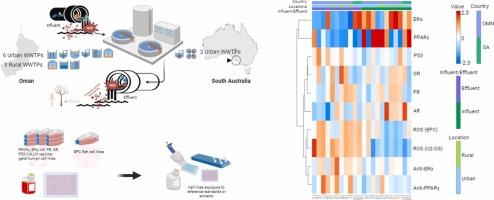利用报告基因测定和鱼细胞系对南澳大利亚和阿曼废水中生物活性化学物质的体外比较评价
IF 11.3
1区 环境科学与生态学
Q1 ENGINEERING, ENVIRONMENTAL
引用次数: 0
摘要
本研究评估了南澳大利亚和阿曼11个污水处理厂的废水,使用先进的体外CALUX和鱼细胞生物测定法,突出了来自新兴关注(CECs)的持久性污染物的挑战。细胞系包括过氧化物酶体增殖物激活受体γ (PPARγ)、雌激素受体α (ERα)、雄激素受体(AR)、糖皮质激素受体(GR)、孕激素受体(PR)和基因毒性(P53)人CALUX细胞和上皮鱼源性细胞(EPC)。对EPC细胞无影响。在南澳大利亚G1和B1站点(分别为0.073和0.054 ng/L E2当量)和阿曼D站点(0.045 ng/L E2当量)的流出物中检测到显著的ERα活性。阿曼Site-G的GR活性仍然显著(0.43 ng/L地塞米松当量)。在南澳大利亚,G1a (0.045 ng/L DHT eq.)和B1a (0.016 ng/L DHT eq.)的AR活性显著,但降至LOD和报告限值以下。同样,在阿曼,进水样品显示出显著的AR活性,经过废水处理后显著降低。检测到的活性物的去除效率具有可比性,具有显著的AR去除率(67%至99.8%)。对于ERα活性,阿曼的大多数处理工艺都取得了显著的去除效果(84%至99.8%),而南澳大利亚的处理工艺则表现出部分的负效率(17%至- 20%)。本文章由计算机程序翻译,如有差异,请以英文原文为准。

Comparative in vitro assessment of bioactive chemicals in wastewater from South Australia and Oman using reporter gene assays and a fish cell line
This study assesses wastewater from eleven WWTPs in South Australia and Oman, highlighting challenges from persistent contaminants of emerging concern (CECs) using advanced in vitro CALUX and fish cell bioassays. The cell lines included peroxisome proliferator-activated receptor gamma (PPARγ), estrogen receptor-α (ERα), androgen receptor (AR), glucocorticoid receptor (GR), progestogenic receptor (PR) and genotoxic (P53) human CALUX cells and epithelial fish-derived cells (EPC). No effects were observed on EPC cells. Significant ERα activity was detected in effluent from Sites G1 and B1 in South Australia (0.073 and 0.054 ng/L E2 equivalent, respectively) and at Site D in Oman (0.045 ng/L E2 equivalent). GR activity remained significant (0.43 ng/L dexamethasone equivalent) at Site-G in Oman. Significant AR activity was observed at G1a (0.045 ng/L DHT eq.) and B1a (0.016 ng/L DHT eq.) in South Australia but decreased to levels below the LOD and reporting limit. Similarly, in Oman, influent samples showed significant AR activity, which was significantly reduced after wastewater treatment. Removal efficiencies of detected activities were comparable, with significant AR removal (67 to 99.8%). For ERα activity, most treatment processes in Oman achieved significant removal (84 to 99.8%), while those in South Australia showed partial to negative efficiencies (17 to −20%).
求助全文
通过发布文献求助,成功后即可免费获取论文全文。
去求助
来源期刊

Journal of Hazardous Materials
工程技术-工程:环境
CiteScore
25.40
自引率
5.90%
发文量
3059
审稿时长
58 days
期刊介绍:
The Journal of Hazardous Materials serves as a global platform for promoting cutting-edge research in the field of Environmental Science and Engineering. Our publication features a wide range of articles, including full-length research papers, review articles, and perspectives, with the aim of enhancing our understanding of the dangers and risks associated with various materials concerning public health and the environment. It is important to note that the term "environmental contaminants" refers specifically to substances that pose hazardous effects through contamination, while excluding those that do not have such impacts on the environment or human health. Moreover, we emphasize the distinction between wastes and hazardous materials in order to provide further clarity on the scope of the journal. We have a keen interest in exploring specific compounds and microbial agents that have adverse effects on the environment.
 求助内容:
求助内容: 应助结果提醒方式:
应助结果提醒方式:


